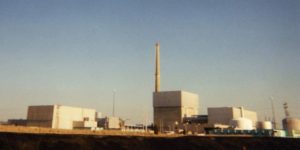
Exelon Corporation, citing costs and other issues, announced that it would close the Oyster Creek nuclear power plant in Lacey, NJ, in October, 2018.
Alex Geecan, covering the story in the Asbury Park Press, here, quoted Neil Sheehan, a spokesman for the Nuclear Regulatory Commission,
“The NRC requires “that the decommissioning process for a nuclear power plant must be completed within 60 years.”
So after producing power for 50 years, the plant will be managed, guarded, and eventually dismantled, a process that may take as long as 60 years.
The Press also quoted Ocean County Freeholder John Bartlett, “The plant’s old radioactive fuel rods, entombed in concrete and steel, will remain guarded at the site of what will become the remnants of the former plant. … Human beings, animals and the environment in general will need to be protected from exposure to the spent fuel rods for perhaps the next 250,000 years.”
These illustrates one of the problems with nuclear power. Despite the massive potential suggested by Einstein’s famous equation, e = mc2 , nuclear power is incredibly inefficient. This plant, for example will have operated for 50 years, may require another 60 years to be decommissioned. And the wastes it will have generated in its 50 year lifespan will require isolation from the biosphere for 250,000 years.
Environment advocates from the New Jersey Sierra Club and Clean Water Action said the announcement was good news for Barnegat Bay and blamed the plant for fish kills and algal blooms. The plant’s cooling system draws cool water from the bay, then releases hot water back.
Freeholder Bartlett thinks the plant should be repurposed for natural gas.
Energy Manager Today, siting National Renewable Energy Lab data here, says A large fixed tilt photovoltaic plant that generates 1 GWh per year requires, on average, 2.8 acres for the solar panels. This means that a solar power plant that provides all of the electricity for 1,000 homes would require 32 acres of land.
Given that:
- Oyster Creek occupies 800 acres,
- the energy infrastructure at the site, and
- Gov. Murphy’s determination to build energy infrastructure of off-shore wind and solar
The writers and editors at Popular Logistics think we should evaluate Oyster Creek for solar energy. Use of 320 acres of the 800 acre Oyster Creek’s site would provide electricity for 10,000 homes. We also think, given Gov. Murphy’s determination to add more solar and wind power to NJ, that Oyster Creek should be evaluated as a landing site for energy from off-shore wind turbines.
–
Lev Josephson, MBA, can be reached at “Lev S Josephson @ Outlook . com.”